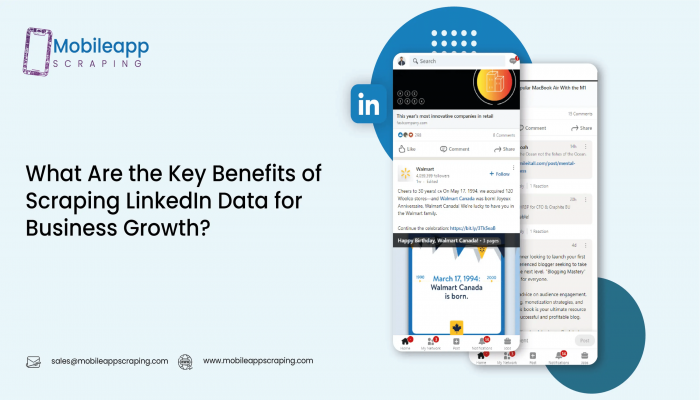 Launch apps instantly. Claim $200 credits on DigitalOcean
Launch apps instantly. Claim $200 credits on DigitalOcean
What Are the Key Benefits of Scraping LinkedIn Data for Business Growth?
Written by MobileApp Scraping » Updated on: March 29th, 2024

What-Are-the-Key-Benefits-of-Scraping-LinkedIn-Data-for-Business-Growth-01
What Are the Key Benefits of Scraping LinkedIn Data for Business Growth?
March 27, 2024
In the digital age, social media platforms serve as invaluable data sources, offering insights into consumer behavior, market trends, and societal dynamics. Social media data scraping involves programmatically extracting information from these platforms, enabling analysis and decision-making across various domains. Among these platforms, LinkedIn stands out as a hub for professional networking, job-seeking, and business development. LinkedIn data collection is crucial because it provides rich insights into professional demographics, skill sets, industry trends, and recruitment patterns.
By scraping LinkedIn data, businesses access a wealth of information for market research, competitor analysis, and talent acquisition. Researchers utilize LinkedIn data to study labor market dynamics, career trajectories, and workforce diversity. Recruitment agencies leverage scraped data to identify potential candidates and track industry trends. Furthermore, LinkedIn data collection enables personalized marketing strategies and targeted advertising campaigns.
Types Of Data Collected From The LinkedIn Mobile App
Types-of-Data-Collected-from-the-LinkedIn-Mobile-App-01
When scraping data from the LinkedIn mobile app, various types of information can be collected, providing insights into users' professional activities and preferences. Some of the critical types of data that can be scraped from the LinkedIn mobile app include:
Profile Information: Scraping can gather details from users' profiles, such as their name, job title, education history, skills, and work experience. This information forms the foundation of users' professional identities on the platform.
Connections and Networks: Scraping can gather data about users' connections with other professionals, including the profiles of their contacts and the strength of their professional networks.
Engagement Metrics: Data scraping can capture users' engagement with content on the platform, including likes, comments, shares, and views on posts, articles, and updates.
Search Queries: Scraping can collect information about users' search queries, including job searches, company searches, and people searches. This data provides insights into users' professional interests and activities.
Location Data: With users' consent, scraping may gather location data to provide location-based services and insights, such as job recommendations and local networking events.
Usage Patterns: Scraping can track users' interactions with the mobile app, including the frequency of logins, time spent on the platform, and features accessed. This data helps analyze user behavior and optimize the user experience.
Ad Interactions: Scraping may capture data related to users' interactions with advertisements on the LinkedIn mobile app, such as clicks on sponsored posts or views of promoted content.
LinkedIn data scraping services can provide valuable insights for research, analysis, and targeted marketing efforts. However, it's essential to consider legal and ethical considerations and users' privacy preferences when collecting and using this data.
Why Scrape LinkedIn Profiles And Company Data?
BWhy-Scrape-LinkedIn-Profiles-and-Company-Data-01
Scrape LinkedIn profiles and company data to gain many benefits across various domains. Here are seven key reasons why scraping this information is valuable:
Talent Acquisition: Companies can use scraped LinkedIn profiles to identify potential candidates for job openings. By analyzing candidates' skills, experience, and endorsements, recruiters can efficiently source talent that aligns with their organization's needs.
Competitive Analysis: Scraping data from competitor profiles and company pages on LinkedIn provides valuable insights into their workforce, industry connections, and strategic initiatives. This information helps businesses benchmark their performance, identify market trends, and refine their strategies to gain a competitive edge.
Market Research: LinkedIn scraping enables researchers and businesses to analyze industry trends, market dynamics, and consumer preferences. By aggregating data from company pages, job postings, and professional profiles, analysts can generate valuable market insights to inform business decisions and strategic planning.
Lead Generation: B2B marketers can use LinkedIn data scrapers to generate leads and build prospect lists. By extracting data from relevant company pages and professional profiles, marketers can effectively identify potential clients, understand their needs, and tailor their outreach efforts.
Networking and Relationship Building: Professionals can leverage scraped LinkedIn data to expand their professional networks and build meaningful relationships. By analyzing profiles of industry peers, influencers, and thought leaders, individuals can identify networking opportunities, establish connections, and engage in collaborative endeavors.
Sales Prospecting: Sales professionals can use scraped LinkedIn data to identify potential leads and prospects. By analyzing company pages, employee profiles, and industry trends, sales teams can prioritize their outreach efforts, personalize their messaging, and drive more effective sales conversations.
Industry Insights and Thought Leadership: Scraped LinkedIn data can be used to identify industry trends, emerging topics, and thought leaders within specific sectors. By analyzing LinkedIn discussions, posts, and engagement metrics, professionals can stay informed about industry developments, share valuable insights, and establish themselves as thought leaders in their respective fields.
Scraping LinkedIn profiles and company data provides valuable insights for talent acquisition, competitive analysis, market research, lead generation, networking, sales prospecting, and thought leadership. However, when scraping information from the platform, it's essential to comply with LinkedIn's terms of service and data privacy regulations.
Role Of LinkedIn Data Scraper In Collecting Data From LinkedIn App
LinkedIn data scraper is crucial in efficiently gathering valuable information from the LinkedIn app for various purposes. These automated tools enable the systematic extraction of comprehensive data from user profiles, company pages, job listings, and engagement metrics. LinkedIn scrapers provide insights into users' professional backgrounds and expertise by collecting profile data, including employment history, skills, and endorsements. Additionally, they aggregate company data, such as company size, industry, and employee profiles, facilitating market analysis and talent acquisition efforts. Job listing aggregation informs users about job market trends and relevant opportunities. Skill and endorsement analysis aids in identifying emerging trends and influential professionals within specific industries. Networking insights from scraped data enhance users' professional networks and relationship-building efforts. Furthermore, content and engagement monitoring provide valuable feedback for content creators and marketers to optimize their strategies. LinkedIn data scraper empowers users with actionable insights for talent acquisition, market research, competitive analysis, networking, and content strategy optimization.
Steps To Scrape LinkedIn Profile Data From Apps With No Code Method
Steps-to-Scrape-LinkedIn-Profile-Data-from-Apps-with-No-Code-Method
If you prefer a no-code method to scrape LinkedIn profile data from apps, you can use various third-party tools that offer scraping capabilities without requiring programming knowledge. Here's a step-by-step guide:
Choose a LinkedIn Scraping Tool:
Select a third-party LinkedIn scraping tool that suits your requirements. Look for tools that offer user-friendly interfaces, robust features, and reliable performance.
Sign Up and Log In:
Sign up for an account on the chosen LinkedIn scraping tool's website. Follow the instructions to log in to your account and access the tool's dashboard or interface.
Set Up a New Task:
Create a new scraping task within the tool's interface. Depending on your tool, this process may involve clicking on a "New Task" or "Create New Project" button and providing relevant details, such as the task name and URL of the LinkedIn profile you want to scrape.
Configure Scraping Settings:
Configure the scraping settings according to your requirements. It may include specifying the data fields you want to extract, setting up filters or conditions to refine your scraping criteria, and adjusting other parameters such as scraping speed and frequency.
Run the Scraping Task:
Once you've configured the scraping settings, initiate the task within the tool's interface. It may involve clicking on a "Run" or "Start" button to begin the scraping process.
Monitor the Scraping Progress:
Monitor the scraping task's progress within the tool's dashboard or interface. Depending on your tool, you can track metrics such as the number of profiles scraped, scraping speed, and any errors or issues encountered during the process.
Review and Export the Scraped Data:
Once the scraping task is complete, review the scraped data within the tool's interface. You can preview the data, clean or filter it as needed, and export it in various formats such as CSV, Excel, or JSON.
Verify Compliance with LinkedIn's Terms of Service:
Before using the scraped data for any purpose, ensure that your scraping activities comply with LinkedIn's terms of service and legal regulations. Avoid violating LinkedIn's policies regarding data scraping and usage to avoid potential repercussions.
By following these steps, you can extract LinkedIn mobile app data using a no-code method with the help of third-party scraping tools. Make sure to choose a reputable tool and exercise caution to comply with LinkedIn's terms of service and legal requirements.
Conclusion
LinkedIn app data scraping provides unparalleled opportunities for extracting valuable insights into professional networks, market dynamics, and talent pools. Through careful extraction and analysis, businesses can make informed decisions, streamline recruitment processes, and identify emerging trends. However, it's imperative to approach scraping ethically and comply with LinkedIn's terms of service to ensure data integrity and user privacy. With the right tools and methodologies, LinkedIn data collection is powerful for gaining a competitive edge and driving strategic growth in the dynamic professional networking and recruitment landscape.
Please contact us with any further questions or help with mobile app scraping. Our team is committed to providing comprehensive support and helping you with all your scraping needs.
Copyright © 2024 IndiBlogHub.com Hosted on Digital Ocean









Post a Comment
To leave a comment, please Login or Register